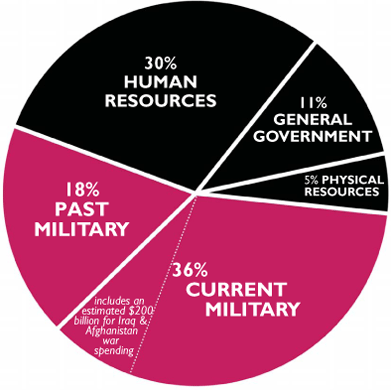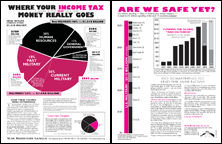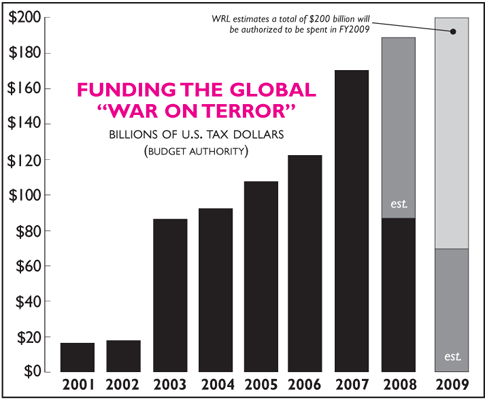|
Current
Military
$965 billion:
•
Military Personnel $129 billion
• Operation & Maint. $241 billion
• Procurement
$143 billion
• Research & Dev. $79 billion
• Construction $15 billion
• Family Housing $3 billion
• DoD misc. $4 billion
• Retired Pay $70 billion
• DoE nuclear weapons $17 billion
• NASA (50%) $9 billion
• International
Security $9 billion
• Homeland Secur. (military) $35 billion
• State Dept. (partial) $6 billion
• other military (non-DoD) $5 billion
• “Global
War on Terror” $200 billion [We added $162 billion to the last
item to supplement the Budget’s grossly underestimated $38 billion in “allowances” to
be spent in 2009 for the “War on Terror,” which includes the wars
in Iraq and Afghanistan]
Past
Military,
$484 billion:
•
Veterans’ Benefits $94 billion
• Interest on national debt (80%) created by military spending, $390 billion
Human
Resources
$789 billion:
• Health/Human Services
•
Soc. Sec. Administration
• Education Dept.
• Food/Nutrition programs
• Housing & Urban Dev.
• Labor Dept.
• other human resources.
General
Government
$304 billion:
• Interest on debt (20%)
•
Treasury
• Government personnel
• Justice Dept.
• State Dept.
• Homeland
Security (15%)
• International Affairs
• NASA (50%)
• Judicial
• Legislative
• other general govt.
Physical
Resources
$117 billion:
• Agriculture
• Interior
• Transportation
• Homeland Security (15%)
• HUD
• Commerce
•
Energy (non-military)
• Environmental Protection
• Nat. Science Fdtn.
• Army Corps Engineers
• Fed. Comm. Commission
• other physical resources

Total
Outlays (Federal Funds):
$2,650 billion
MILITARY: 54% and $1,449 billion
NON-MILITARY: 46% and $1,210 billion

HOW THESE FIGURES WERE DETERMINED
![]() urrent
military” includes Dept. of Defense ($653 billion), the military portion
from other departments ($150 billion), and an additional $162 billion to
supplement the Budget’s misleading and vast underestimate of only
$38 billion for the “war on terror.” “Past military” represents
veterans’ benefits
plus 80% of the interest on the debt.*
urrent
military” includes Dept. of Defense ($653 billion), the military portion
from other departments ($150 billion), and an additional $162 billion to
supplement the Budget’s misleading and vast underestimate of only
$38 billion for the “war on terror.” “Past military” represents
veterans’ benefits
plus 80% of the interest on the debt.*
Source: Congressional Budget Office for FY2008 |
These figures are from an analysis of detailed tables in the “Analytical Perspectives” book of the Budget of the United States Government, Fiscal Year 2009. The figures are federal funds, which do not include trust funds — such as Social Security — that are raised and spent separately from income taxes. What you pay (or don’t pay) by April 15, 2008, goes to the federal funds portion of the budget. The government practice of combining trust and federal funds began during the Vietnam War, thus making the human needs portion of the budget seem larger and the military portion smaller.
*Analysts differ on how much of the debt stems from the military; other groups estimate 50% to 60%. We use 80% because we believe if there had been no military spending most (if not all) of the national debt would have been eliminated. For further explanation, please see box at bottom of page.
|
Are We Safe Yet? | |||
|
|||
| source: For 2001 to 2008 from Center for Arms Control and Non-Proliferation, armscontrolcenter.org; for 2009, the Budget includes $70 billion in “allowances” for GWOT; WRL estimates an additional $130 billion will be authorized for spending in 2009 and subsequent years, making the total authorized $200 billion. This graph shows Budget Authority, while the pie on the front is Outlays. | |||
 |
U.S. Military Spending vs. The World U.S. military spending – Dept. of Defense plus nuclear weapons (in $billions) – is equal to the military spending of the next 15 countries combined. These numbers show military expenditures for each country. Some say that U.S. military spending will naturally be higher because it has the highest Gross Domestic Product (GDP) of any country. The United States accounts for 47 percent of the world’s total military spending, however the U.S.’s share of the world's GDP is about 21 percent. Also note that of the top 15 countries shown, at least 12 are considered allies of the U.S. The U.S. outspends Iran and North Korea by a ratio of 72 to one. Source: Center for Arms Control and Non-Proliferation, http://old.armscontrolcenter.org/archives/002279.php; our graph uses a more comparable figure of $515 from actual 2006 U.S. military spending |
||
WHAT
YOU CAN DO | |
| R
E F U S E T O P A Y F O
R W A R investigate the following sites for more information | |
| Join the 2008 War Tax Boycott! | |
| WRL’s Overview of War Tax Resistance | |
| National
War Tax Resistance Coordinating Committee A national clearinghouse of counselors and information | |
| Hang
Up on War Refuse to pay the federal excise tax on local phone service (the tax on long distance phone service was eliminated in 2006). This tax has been used symbolically as a war tax since the Spanish-American War |
|
- Leaflet with this flyer between now and Tax Day, Tuesday, April 15,
2008. There are peace groups around the country — get out and be visible
against the war!
- Write the President and Congress and demand that war money be used for services instead. Write letters to the editor of your local paper. Send them all copies of this flyer.
- Write letters to the editor
of your local paper. Send all of them copies of this flyer.
- Protest with your money! Sign up at wartaxboycott.org. Refuse to pay all or part of your income tax. Whatever you choose to refuse—$1, $10, the 7% that pays for wars in Iraq and Afghanistan, or more — send a letter to elected officials and tell them why. Though illegal, thousands of people openly participate in this form of protest. You can take control of your paycheck and avoid contributing to the military. Contact us for information or referral to a counselor near you. Contribute resisted tax money to organizations working to help people, provide needed services, or care for victims of war.
- For more about refusing to pay for war, contact the National War Tax Resistance Coordinating Committee, PO Box 150553, Brooklyn, NY 11215, (800) 269-7464; www.nwtrcc.org. Support the Peace Tax Fund bill to allow 100% of your taxes to fund nonmilitary programs: (888) 732-2382; www.peacetaxfund.org.
- Support military personnel who refuse to fight in Iraq and Afghanistan. For more information see www.ivaw.org or www.girights.org. Call the GI Rights Hotline if you are in the military and need help: 800-394-9544.
RESOURCES
You can order the following resources from the WAR RESISTERS LEAGUE, 339 Lafayette Street, New York, NY 10012. (212) 228-0450, fax (212) 228-6193, e-mail: wrl@warresisters.org. Please add 20% for postage.
 Copies
of the print version of this piechart are available for 10 cents each (1-199),
7 cents each
(200 or more), 6 cents each (500+) plus 20% postage. You can also download an
Adobe Acrobat version of it by clicking on the image to the left. You
can download a free Acrobat reader here.
Copies
of the print version of this piechart are available for 10 cents each (1-199),
7 cents each
(200 or more), 6 cents each (500+) plus 20% postage. You can also download an
Adobe Acrobat version of it by clicking on the image to the left. You
can download a free Acrobat reader here.
 Download
a black and white version of the Adobe Acrobat piechart by clicking on
the image to the right.
Download
a black and white version of the Adobe Acrobat piechart by clicking on
the image to the right.- El piechart en el español — FY2009
- For sample brochures and resources on war tax resistance, send a self-addressed stamped (63 cents) envelope to War Resisters League at the New York address below.
- “Your Telephone
Taxes Pay for War,” explanatory brochure. Single copies 50¢. $10/ 100. Cards
to enclose with phone bills, $1 for 12. Read
it online!
- “Our Tax Money, Our Choice: A Call to War
Tax Resistance,” basic brochure on how’s and why’s of war
tax resistance. 50 cents each. $10/100.
- War Tax Resistance: A Guide to Withholding Your Support from the Military — 144-page handbook with history, methods and resources. $15 plus $2 bookrate or $4 priority mail.
| Why Do the Percentages Vary from Group to Group? The U.S. Government says that military spending amounts to 20% of the budget, the Center for Defense Information (CDI) reports 51%, the Friends Committee on National Legislation (FCNL) reports 43%, and the War Resisters League claims 54%. Why the variation? Different groups have different purposes in how they present the budget figures. WRL’s goal has been to show the percentage of money that goes to the military (current and past) so that people paying — or not paying — their federal taxes would know what portion of their payments are military-oriented. Also, some of the numbers are for different fiscal years. There are at least five different factors to consider when analyzing the U.S. budget:
Discretionary Spending. The Center for Defense Information (CDI) has used "discretionary" spending — budget items that Congress is allowed to tinker with — which excludes so-called "mandatory" spending items (such as interest on the national debt and retirement pay). WRL does not make such distinctions and lumps them together. Past
Military Spending. If the government does not have enough money to finance
a war (or spending for its hefty military budgets), they borrow through loans,
savings bonds, and so forth. This borrowing (done heavily during World War II
and the Vietnam War) comes back in later years as "hidden" military spending through
interest payments on the national debt. Outlays vs. Budget Authority. WRL uses "outlays" rather than "budget authority," which is often preferred by the government, news media, and groups such as CDI. Outlays refer to spending done in a particular fiscal year, whereas budget authority refers to new spending authorized over a period of several future years. Consequently, CDI reported $421 billion in FY2005 budget authority for the military and $2,200 billion "over the next five years." While WRL reports outlays of $803 billion, plus an anticipated $162 billion in supplemental spending requests for Iraq and Afghanistan wars, plus $484 billion in past military spending — totaling $1,449 billion — just for FY2009. Function vs. Agency/Department. Not all military spending is done by the Department of Defense. For example, the Department of Energy is responsible for nuclear weapons. Consequently, calculations of military spending should consider the function of the budget item regardless of the department or agency in charge of it. However, not everyone agrees what constitutes a military function. For example, WRL includes the 70% of Homeland Security (which includes the Coast Guard), and half of NASA in military spending, while other groups do not. Federal Funds vs. Unified Budget. WRL uses "federal funds" rather than the "unified budget" figures that the government prefers. Federal funds exclude trust fund money (e.g., social security), which is raised separately (e.g., the FICA and Medicare deductions in paychecks) and is specifically ear-marked for particular programs. By combining trust funds with federal funds, the percentage of spending on the military appears smaller, a deceptive practice first used by the government in the late 1960s as the Vietnam War became more and more unpopular. What period are we talking about? Finally, there is some variation in figures because different fiscal years are used. WRL’s figures (above) are for FY2009 (Oct. 1, 2008 to Sep. 30, 2009) as are the most recent U.S. government figures. FCNL sometimes does their analysis for the most recent completed year or FY2007 (Oct. 1, 2006 to Sep. 30, 2007). |
War
Resisters League
339 Lafayette Street
New York, NY 10012
(212) 228-0450
fax (212) 228-6193
wrl@warresisters.org
WRL homepage
Believing war to be a crime against humanity, the War Resisters League, founded in 1923, advocates Gandhian nonviolence as the method for creating a democratic society free of war, racism, sexism, and human exploitation.





